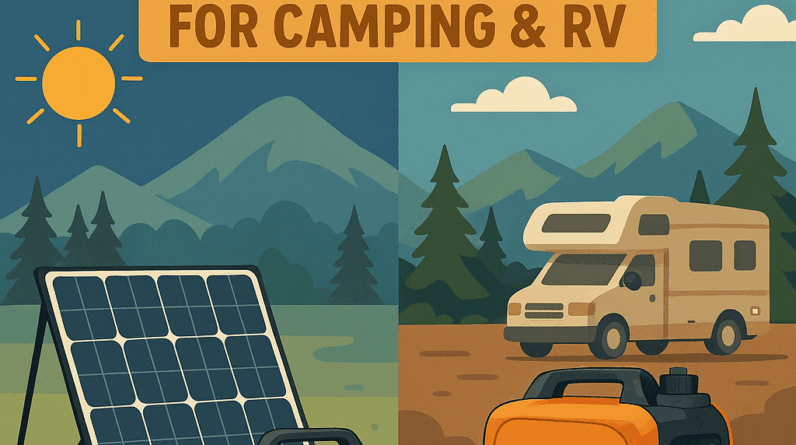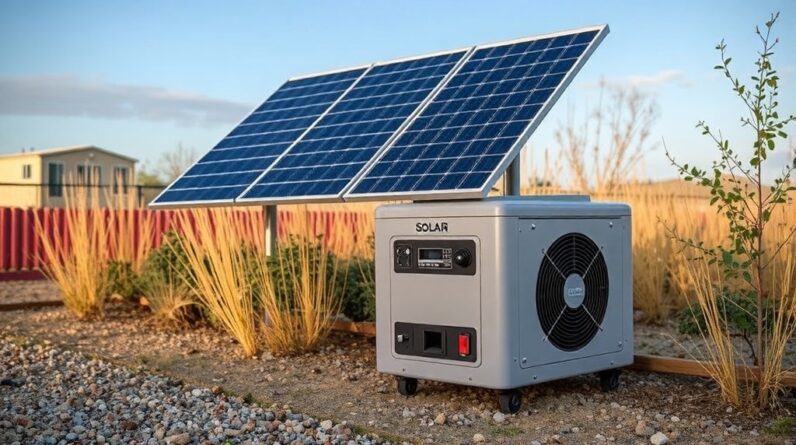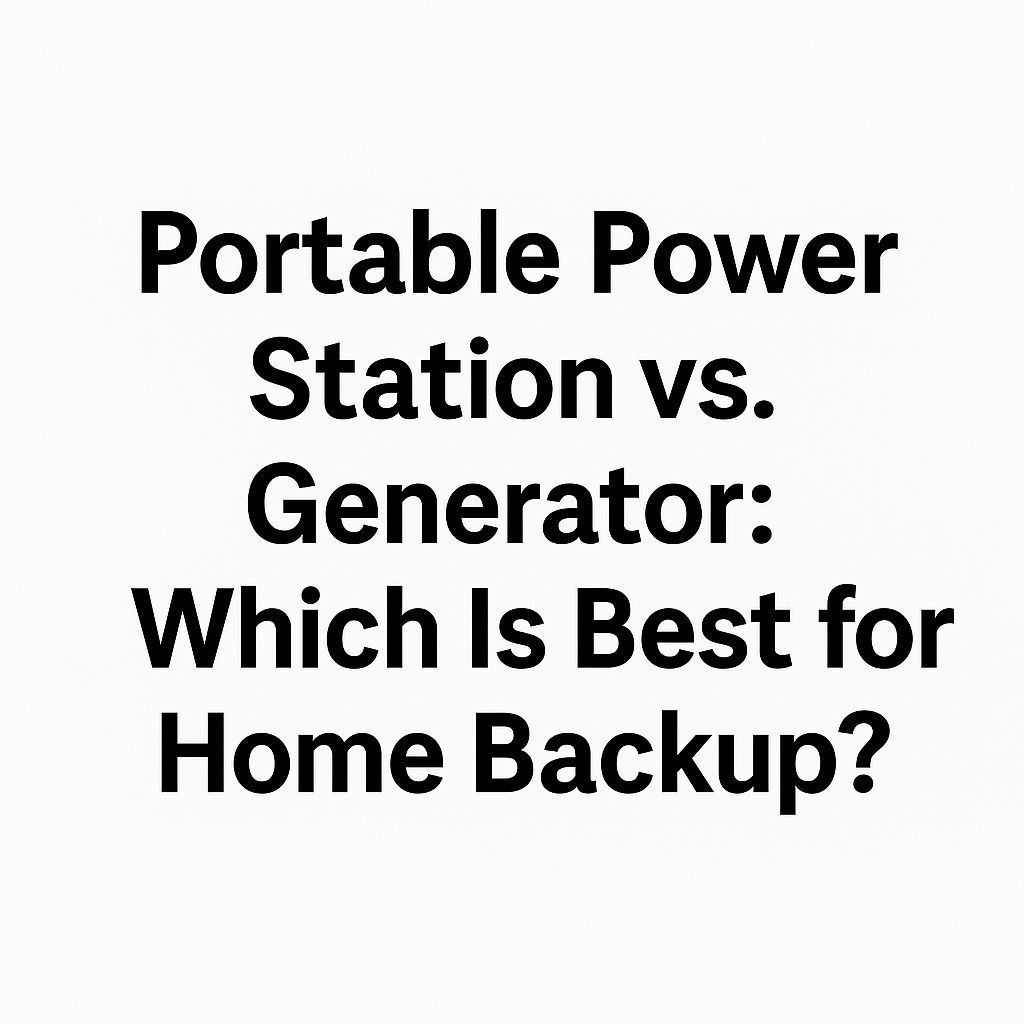
This post contains Amazon affiliate links.
Building Your Own DIY Solar Generator: A Step-by-Step Guide
Building a DIY solar generator can be a rewarding project that provides you with renewable energy while also saving you money on electricity costs. Whether you want backup power during emergencies or are just interested in off-grid living, this step-by-step guide will help you understand the entire process.
Understanding the Basics
A solar generator essentially converts sunlight into electricity through solar panels. This electricity is then stored in batteries for later use. Unlike traditional generators, DIY solar generators are quiet, environmentally friendly, and have lower running costs. You will need to familiarize yourself with some key components before getting started:
- Solar Panels: These absorb sunlight and convert it into electricity.
- Battery: This stores the electricity generated by the solar panels for later use.
- Charge Controller: This protects the batteries from overcharging and excessive discharge.
- Inverter: This converts the stored DC power from the batteries into AC power for home use.
Gathering the Necessary Materials
To construct your own solar generator, you will need to gather specific materials. Here’s a list to help you:
- Two solar panels (e.g., 100W each)
- A charge controller (20A or higher)
- A deep-cycle battery (12V, ideally 100Ah)
- Inverter (300W to 600W)
- Connection cables
- A toolbox (screwdriver, wire cutter, etc.)
- Enclosure (for protection) like a plastic or wooden box
Assembling Your DIY Solar Generator
Follow these steps to assemble your solar generator:
Step 1: Prepare Your Enclosure
Begin by selecting a suitable enclosure for your generator. If you are using a wooden box, sand down sharp edges and paint it with non-toxic paint to protect it from the elements.
Step 2: Install the Charge Controller
Mount the charge controller inside the enclosure. This device is crucial; it will control the flow of electricity from the panels to the battery.
Step 3: Connect the Battery
Connect the deep-cycle battery to the charge controller. Ensure that you maintain the correct polarity—positive to positive and negative to negative. Use appropriate gauge wire for these connections to avoid overheating.
Step 4: Attach the Solar Panels
Now, it’s time to connect the solar panels to the charge controller. Use the same color coding to keep track of positive and negative connections. Make sure your solar panels are pointed in the direction of the sun!
Step 5: Connect the Inverter
Attach the inverter to the battery, making sure of correct polarity. The inverter will provide AC power, allowing you to plug in devices like lamps, laptops, and refrigerators.
Testing Your Solar Generator
Once everything is connected, it’s time to test your solar generator. Follow these tips:
- Place your solar panels outside in direct sunlight.
- Check the charge controller for indicators showing it’s receiving power.
- After a few hours, test the inverter by plugging in a small electrical device.
Maintaining Your Solar Generator
Your DIY solar generator will require some maintenance to ensure longevity:
- Keep solar panels clean for optimal efficiency.
- Check battery levels regularly and cycle the battery to prolong its life.
- Inspect connections and cables for wear and corrosion.
Final Thoughts on DIY Solar Generators
Building a DIY solar generator is not only a practical way to harness renewable energy but also an exciting project. With some basic tools and materials, you can create a power source that benefits both the environment and your pocket. Remember to take your time and follow each step carefully!
For those interested in self-sufficiency, a DIY solar generator can be a great investment. Soon, you’ll be enjoying the benefits of clean, sustainable power right in your own home.
Essential Components for a Successful Solar Generator
If you’re considering building a DIY solar generator, understanding the essential components will help you create an effective and reliable system. Each part plays a crucial role in harnessing and utilizing solar energy for your power needs. Here’s a closer look at the key components you need.
Solar Panels
The foundation of any solar generator is the solar panels. These panels capture sunlight and convert it into electricity. When choosing solar panels, consider the following:
- Type: Monocrystalline panels typically offer higher efficiency but come at a higher cost. Polycrystalline panels are often more affordable, but slightly less efficient.
- Wattage: Determine how much power you need. Panels usually range from 100W to 300W or more.
- Durability: Look for panels with a good warranty period to ensure they can withstand environmental conditions.
Charge Controller
A charge controller is vital for managing the energy that flows from the solar panels to the battery. It prevents overcharging and regulates voltage. Here are some features to consider:
- Types: PWM (Pulse Width Modulation) controllers are cheaper but less efficient, while MPPT (Maximum Power Point Tracking) controllers offer higher efficiency.
- Compatibility: Make sure the charge controller matches your solar panel and battery specifications.
- Monitoring: Some controllers provide real-time data, helping you track energy production and consumption.
Batteries
Battery storage is critical for your solar generator, as it allows you to store energy for use when there’s no sunlight. Factors to consider when selecting batteries include:
- Type: Lithium-ion batteries are lightweight and have long lifespans, while lead-acid batteries are heavier but more affordable.
- Capacity: Measure the total capacity necessary to meet your energy needs—in amp-hours (Ah).
- Depth of Discharge (DoD): This refers to how much of the battery’s capacity can be safely used. For lithium batteries, aim for a DoD of 80-90%.
Inverter
The inverter converts the DC electricity generated by the solar panels and stored in the battery into usable AC electricity for your appliances. Key points to keep in mind include:
- Wattage: Choose an inverter that can handle the total wattage of the devices you’ll be using.
- Sine Wave Type: Pure sine wave inverters are best for sensitive electronics, while modified sine wave inverters can work for less sensitive devices.
- Efficiency: Look for inverters with high efficiency ratings, as this affects overall system performance.
Connecting Cables and Accessories
Don’t overlook the importance of the connecting cables and accessories in your solar generator setup. You’ll need:
- Cables: Ensure you select appropriate gauge cables for connecting all components.
- Connectors: Use connectors that are compatible with your solar panels and charge controller.
- Mounting Hardware: Ensure you have reliable mounts for your panels to capture maximum sunlight.
Safety Equipment
Safety should always be your top priority. To protect your investment and ensure safe operation, consider the following:
- Circuit Breakers: Install circuit breakers to prevent overloads.
- Fuses: Use fuses to protect wiring from overheating.
- Battery Monitor: This device provides real-time feedback on the battery’s state of charge and health.
Designing your solar generator might seem overwhelming, but by understanding these essential components, you can create a reliable energy source. Remember to research and choose the right components based on your specific energy needs and budget. By investing time into selecting quality parts and ensuring they work well together, you’ll be able to enjoy the benefits of solar energy for years to come.
Benefits of Using a DIY Solar Generator for Emergency Power
When disaster strikes or an unexpected power outage occurs, having a reliable source of emergency power is crucial. A DIY solar generator can be a game-changer in such situations. Unlike traditional generators that run on fossil fuels, solar generators harness the sun’s energy to provide electric power. This method is not only eco-friendly but also offers a plethora of benefits worth considering.
Cost-Effective Energy Solution
One of the most significant advantages of building a DIY solar generator is the cost savings. Compared to purchasing a pre-made solar generator, creating your own can substantially reduce expenses. With a little research and effort, you can often gather materials at a fraction of the price. You get to choose components according to your budget and specific needs.
Eco-Friendly Power Source
Solar energy is one of the cleanest and most sustainable energy sources available. By utilizing a DIY solar generator, you contribute less to pollution and greenhouse gas emissions. This eco-conscious approach not only helps the planet but also allows you to feel good about your energy choices in an increasingly environmentally aware society.
Customization to Your Needs
When you build your DIY solar generator, you can customize it to meet your particular power needs. Depending on your requirements, you can select different components, such as solar panels, batteries, and inverters.
- Choose the Right Solar Panels: Depending on the space you have, you can opt for smaller or larger panels.
- Battery Capacity: Select batteries according to how much power you need to store for emergencies.
- Inverter Options: Decide on the type of inverter that can convert DC to AC power based on your gadgets.
Increased Self-Reliance
Relying on the electric grid can leave you vulnerable during emergencies. Building a DIY solar generator empowers you to take control of your energy needs. You can generate your own power, ensuring that you have backup energy whenever you need it. This self-sufficiency is particularly valuable in remote areas or during natural disasters when access to traditional power sources might be compromised.
Easy Maintenance
Compared to gas-powered generators, solar generators require much less maintenance. There are no engine parts to service, oil checks to perform, or fuel to refill. The primary maintenance involves keeping your solar panels clean and ensuring that batteries are functioning optimally. This ease of maintenance makes a DIY solar generator an attractive option for those looking for a low-hassle power solution.
Quiet Operation
Solar generators operate quietly, making them ideal for use in residential areas or while camping. Unlike gas generators that produce noise and vibrations, a solar generator operates almost silently. This peaceful output allows you to enjoy your environment without disturbing neighbors or wildlife.
Accessibility of Information
With the rise of the DIY movement, there is a wealth of resources available to help you build your solar generator. From online tutorials to detailed videos, finding guidance on how to start your project is just a few clicks away. This accessibility fosters community support, allowing you to connect with others interested in DIY solar power solutions. You can ask questions, share tips, and get advice on common challenges.
Support for Multiple Devices
A DIY solar generator can support a variety of devices, making it highly versatile. You can use it to power:
- Lights and small appliances
- Refrigerators
- Phones and laptops
- Medical devices
This flexibility means you can tailor your setup to suit a wide range of emergency situations, ensuring that the most important devices stay powered.
Enhancing Emergency Preparedness
Having a DIY solar generator is an excellent step toward total preparedness. It encourages you to think ahead and plan for unforeseen circumstances. By investing time and resources into setting up a solar generator, you’re not just investing in a power source but also enhancing the overall safety and comfort of your home during emergencies.
Opting for a DIY solar generator for emergency power provides numerous benefits, from cost savings and ecological advantages to customization and ease of maintenance. By taking this initiative, you can significantly enhance your emergency readiness, paving the way for a more resilient and self-sufficient lifestyle.
Cost Analysis: Is a DIY Solar Generator Right for You?
If you have been considering the shift to solar energy, constructing a DIY solar generator might be a great project for you. But how do you determine if it’s the right investment? A comprehensive cost analysis can help clarify this. In this discussion, we will break down the expenses involved with crafting your own solar generator and evaluate if this option makes sense for your lifestyle and needs.
To start, let’s identify the primary components needed to build a DIY solar generator:
- Solar Panels: The heart of your generator, converting sunlight into electricity.
- Battery: Stores energy produced by your solar panels for later use.
- Charge Controller: Regulates the voltage to prevent overcharging the battery.
- Inverter: Converts the direct current (DC) from the battery to alternating current (AC) for your devices.
- Cables & Connectors: Necessary to set up the system and keep it connected safely.
Now, let’s look at the estimated costs for each component of a DIY solar generator:
- Solar Panels: The cost typically ranges from $100 to $300 per panel, depending on the wattage.
- Battery: Deep cycle batteries can cost between $150 and $400, with lithium options being pricier.
- Charge Controller: Expect to pay around $20 to $60 for a decent unit.
- Inverter: Usually, these can be found for $100 to $200, based on your power requirements.
- Cables & Connectors: These can be quite affordable, ranging between $20 and $50.
When you tally up these costs, a basic DIY solar generator could set you back anywhere from $400 to $1,200. This range largely depends on the scale of your project and the quality of components you choose. For instance, bulk buying or choosing mid-range products can help reduce costs while still maintaining efficiency.
However, it’s crucial to consider the long-term savings versus the upfront costs. Solar generators typically have low operating costs, as they utilize free sunlight. Many projects pay for themselves in a few years through savings on electricity bills or by avoiding gas and generator maintenance costs. Depending on your energy consumption, a DIY solar generator might become more economical in the long run than relying on conventional energy sources.
Here are some factors you should consider when evaluating if a DIY solar generator is the right choice for you:
- Energy Needs: Assess how much energy you consume in a typical day. For portable applications or RV use, a small setup might suffice.
- Investment in Learning: Building a solar generator requires time, effort, and a willingness to learn about solar technology.
- Availability of Sunlight: Ensure you live in an area with adequate sunlight. If your location is often cloudy, consider alternative energy solutions.
- Space for Setup: Evaluate if you have the necessary space to install solar panels without obstruction.
- Future Scaling: Think about whether your energy needs might increase. Designing a scalable system can offer flexibility.
Moreover, if you’re ecstatic about hands-on projects, making a DIY solar generator can be rewarding. It offers practical experience in solar technology and enhances your understanding of energy sources. Additionally, the satisfaction of producing your own power contributes to a greener lifestyle.
Conversely, if troubleshooting electronics isn’t your strong suit or you prefer not to deal with potential issues, investing in a commercial solar generator might be more suitable. These units, though more expensive upfront, come with warranties and support, reducing the hassle thought by some DIY projects.
Performing a cost analysis of a DIY solar generator involves understanding both the initial expenses and the long-term benefits. By weighing your energy requirements, personal skills, and the practicality of solar energy in your specific situation, you will be better prepared to make an informed decision.
Ultimately, a DIY solar generator can be an exciting and practical project, fostering a sustainable lifestyle while powering your essential devices effectively. Explore your options, calculate your costs, and embark on this green journey today!
Tips for Maintaining Your DIY Solar Generator for Long-Term Use
Maintaining your DIY solar generator is key to ensuring it works efficiently for years to come. With proper care, you can maximize its lifespan and performance. Here are some practical tips and strategies to help you maintain your solar generator.
Regularly Check Your Solar Panels
Your solar panels are the heart of your DIY solar generator. Ensuring they are clean and in good condition is crucial for optimal performance. Here’s how to care for them:
- Clean Panels: Dust, dirt, and debris can block sunlight from reaching the solar cells. Clean them regularly with a gentle soap solution and a soft cloth. Avoid using abrasive materials that could scratch the surface.
- Inspect for Damage: Check for any cracks, chips, or discoloration on the panels. If you notice any damage, it’s important to address it quickly to prevent further issues.
- Monitoring Angle: Ensure your solar panels remain at the optimal angle to maximize sunlight exposure. Periodically adjust them according to the season and sun path.
Battery Care and Maintenance
The batteries in your solar generator store the energy your system generates. Proper maintenance will keep them functioning effectively. Follow these tips:
- Regular Charging: Keep batteries charged regularly. Deep discharges can reduce their lifespan. Try to maintain a charge between 20-80% to extend battery life.
- Check Water Levels: If you’re using lead-acid batteries, check the water levels every few months. Refill with distilled water if necessary to prevent battery damage.
- Monitor Battery Connections: Ensure all connections are stable and free from corrosion. Clean any corroded terminals with a wire brush and a solution of baking soda and water.
Inverter Maintenance
The inverter transforms the stored energy into usable power for your devices. Regular maintenance can prevent performance issues:
- Keep it Cool: Make sure your inverter is in a cool, well-ventilated area. Excess heat can damage the components, leading to inefficient performance.
- Inspect for Overheating Signs: Watch for any warning lights or unusual noises. If your inverter seems to be overheating, turn it off and allow it to cool down before investigating the issue.
Control System Checks
The control system manages energy flow and prevents overcharging. Ensure it functions properly with these strategies:
- Test the Controller: Check the functionality of your charge controller regularly. Look for any display errors and follow the manufacturer’s corrective guidelines.
- Observe System Performance: Keep track of how much energy you are producing versus what you’re using. Any significant discrepancies may indicate a problem that needs addressing.
Protecting Your System from the Elements
Your solar generator will face outdoor elements, so it’s important to protect it:
- Weatherproof Your Equipment: If your system is exposed to rain or snow, ensure all components are properly weatherproofed. Using enclosures can shield your batteries and inverter from moisture.
- Secure Wiring: Ensure all wiring is secured and protected from animals and environmental damage. Use conduit or protective tubing as needed.
Periodic Professional Inspections
While you can maintain your DIY solar generator, consider having it inspected by a professional every few years. An expert can identify hidden issues you may overlook, ensuring your system runs at peak efficiency.
Implementing these tips can significantly extend the lifespan and effectiveness of your DIY solar generator. Proper maintenance ensures that you maximize your investment and enjoy clean, renewable energy for the long term. Regular checks, protective measures, and professional assessments contribute to a system that is ready to meet your energy needs while minimizing environmental impact.
Maintaining a DIY solar generator doesn’t have to be complicated. By staying proactive with inspections and upkeep, you can create a reliable energy system that supports sustainable living. Now you can make the most of the power of the sun!
Conclusion
Creating your own DIY solar generator can be a rewarding experience that not only empowers you with energy independence but also provides a sustainable solution for emergency power needs. By following a clear step-by-step guide, you can assemble essential components like solar panels, batteries, and an inverter that work seamlessly together.
The benefits of having a DIY solar generator in times of emergency cannot be overstated. It offers you peace of mind, knowing that you have a reliable energy source when traditional power sources fail. Plus, you gain insight into renewable energy technologies and hands-on skills that can further enhance your understanding of energy management.
When considering the financial aspect, it’s crucial to evaluate the cost of building a solar generator versus buying a pre-made unit. With prices for components varying widely, taking a closer look can reveal potential savings. Ultimately, your choice depends on your budget, skills, and long-term goals for energy use.
To ensure your DIY solar generator lasts as long as possible, proper maintenance is key. Regularly checking the battery health, keeping panels clean, and monitoring connections can significantly enhance performance and longevity.
Investing time and resources into a DIY solar generator not only prepares you for unforeseen power outages but also contributes to a greener, more sustainable future. With dedication and a little ingenuity, you can enjoy the benefits of renewable energy while fostering independence and resilience. Embrace this opportunity, and you will be well-equipped to face any power challenge that comes your way.
This post contains Amazon affiliate links.






